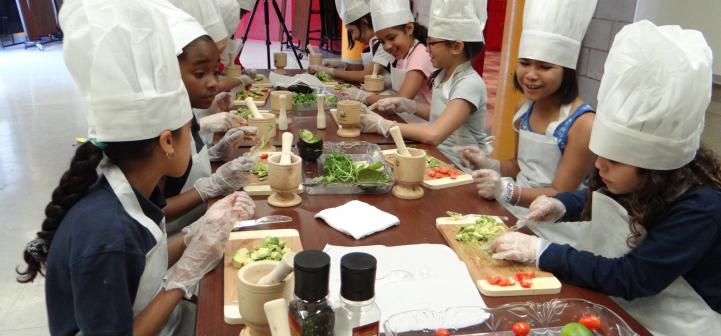
Often when you ask children, “What subject would you like to learn more about?” cooking is a common response. When children engage in learning about food preparation they are able to touch dough, smell herbs, and taste a new food. Involving multiple senses helps children learn new concepts and often make learning more engaging. According to the Afterschool Alliance in 2014 10.2 million children participated in afterschool programs. Time before or afterschool or during the summer is an opportunity for children to engage more fully in a specific subject. Teaching about cooking and food preparation in an afterschool or summer program is an excellent opportunity to teach children and youth about foods, food preparation, and nutrition.
Teaching about foods and food preparation can be complicated but essential to teach young people these skills and help them confidence so they can establish life long healthy habits. Selecting and offering high quality curricula and programming will ensure a successful learning experience. Below is a list of questions one should ask when selecting high quality food preparation curricula or programs:
- Does the curriculum follow U. S. Dietary guidelines and other nutrition recommendation such as MyPlate (https://www.choosemyplate.gov)?
- Do you need electricity, water, tables, or appliances such as a range, microwave or refrigeration? Will the physical space be large enough to accommodate the number of youth you are teaching?
- What is the cost to implement? How much does it cost to purchase the ingredients for the recipe? How much will other supplies cost for the number of children?
- What is the recommended age or grade level for the curricula? Will children and youth this age be able to safely preform the tasks? Are the concepts of the curricula developmentally appropriate?
- How much time will it take to complete the lesson? Can it be safely done in the amount of time allotted?
- Does the curriculum or program favor or have bias for one culture or another? Would some of the food being prepared not be eaten by a diverse group of people?
- Does the curriculum offer several recipes to teach the desired content? How can the recipe be adapted for food allergies, religious practices, or other food preferences?
- Does the curriculum engage youth in the Kolb’s experimental learning process? Does it allow children to physically touch food and practice food preparation skills? Does it allow children an opportunity to be curious and ask questions? Is the lesson taught more by facilitation than lecture?
- What does the program or curriculum state about safety? Is a youth/adult ratio recommended? What equipment is used that might be a safety risk and how is that risk minimized when teaching the lesson?
- How many lessons are in the curriculum? Does it provide enough content to help youth learn new skills and knowledge?
- Who authored the curriculum? Is the curriculum written by a research-based source that has knowledge of best educational practices and age appropriate learning?
- Does the curriculum follow and teach best practices in food safety?
The out of school time hours provide an excellent opportunity for children and youth to learn about foods and food preparation in an informal setting. To make the most of this opportunity it is important to provide a high quality learning experience to enable children and youth to develop skills that will establish lifelong healthy eating patterns and practices.
Contributor
Michelle Krehbiel, PhD, University of Nebraska- Lincoln Extension
Photo by Coqui the Chef / CC BY http://creativecommons.org/licenses/by/2.0/
